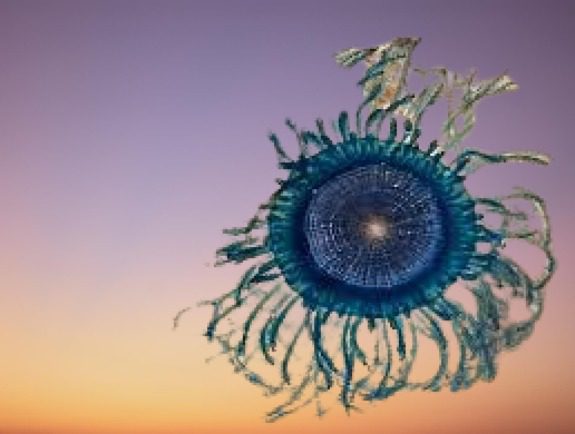Washing Up on Texas Beaches: Picture yourself walking along the sandy shores of a Texas beach, enjoying the warmth of the sun and the gentle rhythm of the waves. Amidst the seashells and driftwood, you come across a captivating sight that immediately piques your curiosity. But this is no ordinary beach find. It’s a peculiar blue creature that demands your attention, and getting too close could result in an unpleasant sting.
Description of Blue Buttons
The Texas Parks and Wildlife recently made an intriguing announcement: Blue Buttons have been spotted at Galveston Island State Park. These fascinating organisms may resemble small, bright blue jellyfish at first glance, but they are actually a distant relative with their own unique characteristics.
A Distant Relative of Jellyfish
Scientifically known as Porpita porpita, Blue Buttons belong to the hydrozoa family, just like jellyfish. However, they possess distinctive features that set them apart from their jellyfish counterparts.
Unveiling the Secrets of Blue Buttons
Blue Buttons are not individual organisms but rather a complex colony of many small hydroid animals. Within this colony, there is a central floating body, often referred to as a “float,” and streaming tentacles resembling those of typical jellyfish.
Stinging Nematocysts
While Blue Buttons may not be as dangerous as jellyfish, they do possess a commonality that can cause discomfort: stinging nematocysts. These specialized cells contain coiled threads with stinging barbs, and coming into contact with their white-tipped tentacles can result in an unpleasant sting.
Understanding the Nematocysts’ Mechanism
When a Blue Button’s tentacle is stimulated, the nematocysts release the coiled threads and stinging barbs, injecting a poisonous liquid into the target. It’s a defense mechanism that helps these creatures survive in their marine environment.
The Sting and Its Effects
While the sting of Blue Buttons is not life-threatening to humans, it can cause skin irritation and discomfort. It’s important to be cautious and avoid touching these fascinating creatures to prevent any unnecessary discomfort.
From Turquoise to Yellow
Interestingly, Blue Buttons are not always the vibrant blue hue that we typically associate with them. They can also appear in shades of turquoise or even yellow, adding to their intrigue and beauty.
Also Read: Alzheimer’s Drug Receives Approval
Food Source and Behavior
Blue Buttons are commonly found along the shores of the Gulf of Mexico, particularly during the summer months. They are attracted to shorelines by plankton blooms, which serve as their primary source of food. Instead of swimming, Blue Buttons prefer to float, relying on ocean currents to navigate.
Observations and Reactions
The Texas Parks and Wildlife’s Facebook warning about the presence of Blue Buttons has sparked a flurry of comments from beachgoers who have encountered these unique organisms. People share their observations, reactions, and experiences.
Reactions from Beachgoers
Some individuals express their admiration, finding the Blue Buttons beautiful in their own peculiar way. Others, however, prefer to keep a safe distance, recognizing the potential for discomfort that lies within those colorful tentacles.
Conclusion of Washing Up on Texas Beaches
Blue Buttons, with their fascinating colony structure and stinging nematocysts, add an element of intrigue and caution to the Texas beaches they inhabit. While admiring their beauty from a safe distance, beachgoers should be mindful of the potential discomfort associated with these captivating creatures. So, the next time you find yourself on a Texas beach, keep an eye out for these blue wonders and appreciate their uniqueness while avoiding any unexpected stings.
Also Read: Quits After Six Years of Marriage
Our Reader’s Queries
Why are fish washing up on Texas beaches?
An event took place at Quintana Beach, close to Freeport, Texas and the mouth of the Brazos River. The Texas Parks and Wildlife team, known as the Kills and Spills Team, conducted an investigation and found that the fish kill was due to a low dissolved oxygen event.
Why do Texas beaches have so much fecal matter?
Urban runoff, sewage overflows, and industrial livestock manure contribute to fecal contamination. In 2022, about 50% of U.S. beaches showed potentially unsafe contamination levels.
Which Texas beaches have bacteria?
Texans love to visit South Padre Island, Corpus Christi, Galveston, and other Gulf Coast beaches. Sadly, a recent study by Environment America revealed that 90% of Texas beaches experienced unsafe fecal contamination in 2022, significantly higher than the national average of 55%.
How clean are Texas beaches?
Environment Texas, a nonprofit organization, discovered that 90% of Texas beaches examined in 2022 were found to have tested positive for fecal bacteria at least once. The presence of pathogens in fecal matter can pose a serious health threat to swimmers, leading to potential beach closures for the safety of the public.

